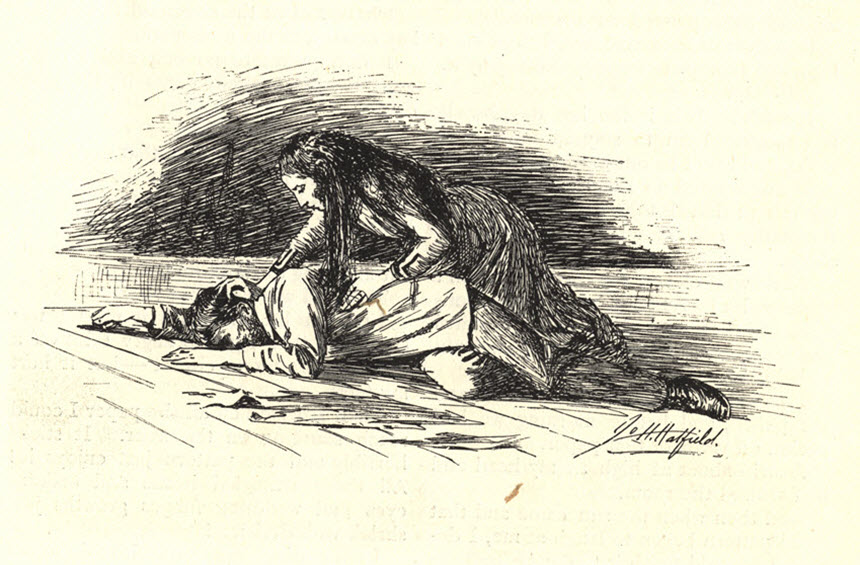The story ends with the narrator’s husband discovering his wife maniacally circling the bedroom, surrounded by the tattered shreds of paper she has torn from the walls. He faints at the sight.
The narrator of “The Yellow Wall-Paper,” imprisoned in her room, The New England Magazine, January 1892
Courtesy National Library of Medicine
After separating from her husband, Charlotte Perkins Gilman wrote “The Yellow Wall-Paper,” during a heat wave in Pasadena, California in the summer of 1890. She took two days to complete the shocking story. The narrator is a woman prescribed the rest cure by her husband John, a physician. She was not allowed to read, write, feed herself, or talk to others. Confined to her bedroom, a former children’s nursery with bars on the windows, she secretly writes in her diary. As the weeks go by, her mind deteriorates as her forced isolation and the prohibition against intellectual pursuits take their toll.
The narrator and her caretaker, Jennie, The New England Magazine, January 1892
Courtesy National Library of Medicine
With only her immediate surroundings to look at, the character becomes increasingly perplexed by the garish color and intricate patterns of the wallpaper all around her. She begins to see distorted shapes, eventually identifying a woman trapped behind the paper fighting to get out. Empathizing with the figure because of their shared imprisonment, the narrator tears down the wallpaper to end her own visions and free her fellow inmate.
The narrator with her husband, who has fainted after finding her in deep distress, The New England Magazine, January 1892
Courtesy National Library of Medicine
The story ends with the narrator’s husband discovering his wife maniacally circling the bedroom, surrounded by the tattered shreds of paper she has torn from the walls. He faints at the sight.
The narrator of “The Yellow Wall-Paper,” imprisoned in her room, The New England Magazine, January 1892
Courtesy National Library of Medicine
After separating from her husband, Charlotte Perkins Gilman wrote “The Yellow Wall-Paper,” during a heat wave in Pasadena, California in the summer of 1890. She took two days to complete the shocking story. The narrator is a woman prescribed the rest cure by her husband John, a physician. She was not allowed to read, write, feed herself, or talk to others. Confined to her bedroom, a former children’s nursery with bars on the windows, she secretly writes in her diary. As the weeks go by, her mind deteriorates as her forced isolation and the prohibition against intellectual pursuits take their toll.
The narrator and her caretaker, Jennie, The New England Magazine, January 1892
Courtesy National Library of Medicine
With only her immediate surroundings to look at, the character becomes increasingly perplexed by the garish color and intricate patterns of the wallpaper all around her. She begins to see distorted shapes, eventually identifying a woman trapped behind the paper fighting to get out. Empathizing with the figure because of their shared imprisonment, the narrator tears down the wallpaper to end her own visions and free her fellow inmate.
The narrator with her husband, who has fainted after finding her in deep distress, The New England Magazine, January 1892
Courtesy National Library of Medicine
The story ends with the narrator’s husband discovering his wife maniacally circling the bedroom, surrounded by the tattered shreds of paper she has torn from the walls. He faints at the sight.
The story ends with the narrator’s husband discovering his wife maniacally circling the bedroom, surrounded by the tattered shreds of paper she has torn from the walls. He faints at the sight.







